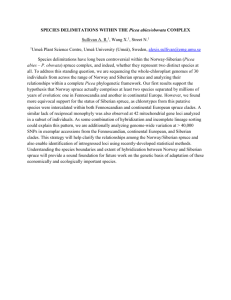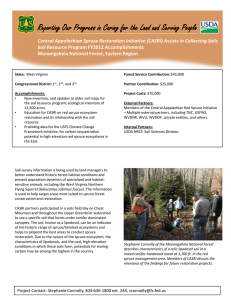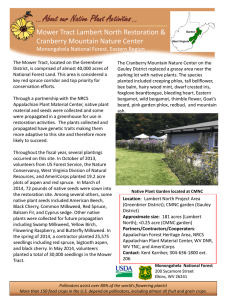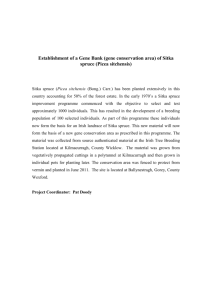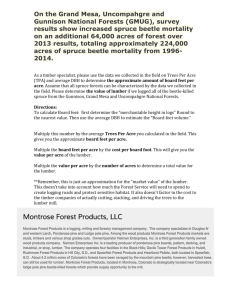The Effects of Silvicultural Manipulations On Spruce Beetle Populations INT-EM-07-04
advertisement
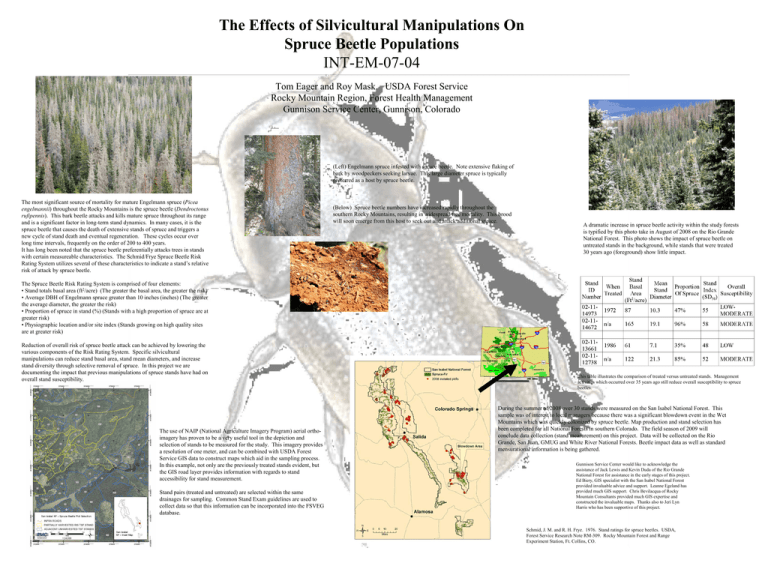
The Effects of Silvicultural Manipulations On Spruce Beetle Populations INT-EM-07-04 Tom Eager and Roy Mask. USDA Forest Service Rocky Mountain Region, Forest Health Management Gunnison Service Center, Gunnison, Colorado (Left) Engelmann spruce infested with spruce beetle. Note extensive flaking of bark by woodpeckers seeking larvae. This large diameter spruce is typically preferred as a host by spruce beetle. The most significant source of mortality for mature Engelmann spruce (Picea engelmannii) throughout the Rocky Mountains is the spruce beetle (Dendroctonus rufipennis). This bark beetle attacks and kills mature spruce throughout its range and is a significant factor in long-term stand dynamics. In many cases, it is the spruce beetle that causes the death of extensive stands of spruce and triggers a new cycle of stand death and eventual regeneration. These cycles occur over long time intervals, frequently on the order of 200 to 400 years. It has long been noted that the spruce beetle preferentially attacks trees in stands with certain measureable characteristics. The Schmid/Frye Spruce Beetle Risk Rating System utilizes several of these characteristics to indicate a stand’s relative risk of attack by spruce beetle. (Below) Spruce beetle numbers have increased rapidly throughout the southern Rocky Mountains, resulting in widespread tree mortality. This brood will soon emerge from this host to seek out and attack additional spruce. A dramatic increase in spruce beetle activity within the study forests is typified by this photo take in August of 2008 on the Rio Grande National Forest. This photo shows the impact of spruce beetle on untreated stands in the background, while stands that were treated 30 years ago (foreground) show little impact. The Spruce Beetle Risk Rating System is comprised of four elements: • Stand totals basal area (ft2/acre) (The greater the basal area, the greater the risk) • Average DBH of Engelmann spruce greater than 10 inches (inches) (The greater the average diameter, the greater the risk) • Proportion of spruce in stand (%) (Stands with a high proportion of spruce are at greater risk) • Physiographic location and/or site index (Stands growing on high quality sites are at greater risk) Reduction of overall risk of spruce beetle attack can be achieved by lowering the various components of the Risk Rating System. Specific silvicultural manipulations can reduce stand basal area, stand mean diameters, and increase stand diversity through selective removal of spruce. In this project we are documenting the impact that previous manipulations of spruce stands have had on overall stand susceptibility. The use of NAIP (National Agriculture Imagery Program) aerial orthoimagery has proven to be a very useful tool in the depiction and selection of stands to be measured for the study. This imagery provides a resolution of one meter, and can be combined with USDA Forest Service GIS data to construct maps which aid in the sampling process. In this example, not only are the previously treated stands evident, but the GIS road layer provides information with regards to stand accessibility for stand measurement. Stand pairs (treated and untreated) are selected within the same drainages for sampling. Common Stand Exam guidelines are used to collect data so that this information can be incorporated into the FSVEG database. This table illustrates the comparison of treated versus untreated stands. Management activities which occurred over 35 years ago still reduce overall susceptibility to spruce beetles. During the summer of 2008 over 30 stands were measured on the San Isabel National Forest. This sample was of interest to local managers because there was a significant blowdown event in the Wet Mountains which was quickly colonized by spruce beetle. Map production and stand selection has been completed for all National Forests in southern Colorado. The field season of 2009 will conclude data collection (stand measurement) on this project. Data will be collected on the Rio Grande, San Juan, GMUG and White River National Forests. Beetle impact data as well as standard mensurational information is being gathered. Gunnison Service Center would like to acknowledge the assistance of Jack Lewis and Kevin Duda of the Rio Grande National Forest for assistance in the early stages of this project. Ed Biery, GIS specialist with the San Isabel National Forest provided invaluable advice and support. Leanne Egeland has provided much GIS support. Chris Bevilacqua of Rocky Mountain Consultants provided much GIS expertise and constructed the invaluable maps. Thanks also to Jeri Lyn Harris who has been supportive of this project. Schmid, J. M. and R. H. Frye. 1976. Stand ratings for spruce beetles. USDA, Forest Service Research Note RM-309. Rocky Mountain Forest and Range Experiment Station, Ft. Collins, CO.

